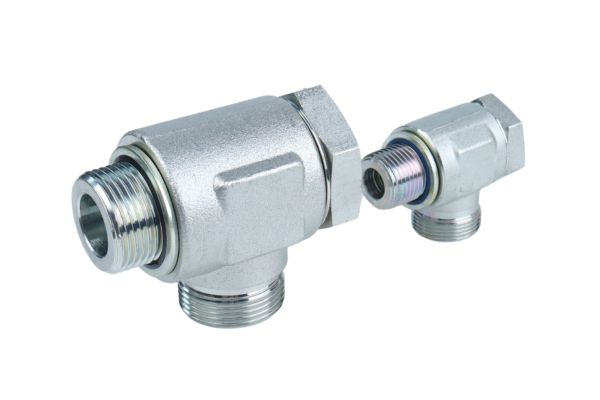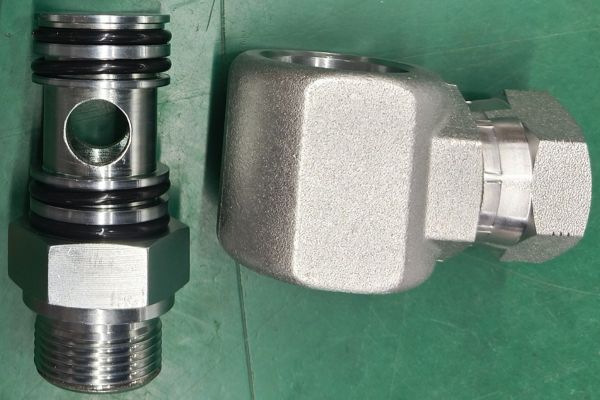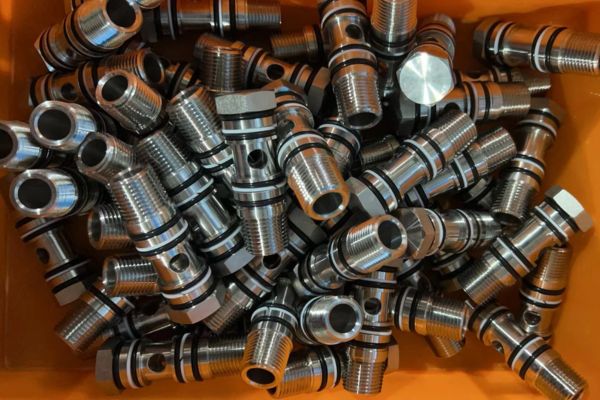Live swivel fittings represent a critical advancement in hydraulic system design, serving as essential components that significantly extend hose life and improve operational efficiency. By allowing connected parts to rotate freely while maintaining fluid integrity, these specialized fittings prevent the twisting and kinking that commonly lead to premature hose failure. As hydraulic systems evolve across industries from forestry to mining, swivel fittings have become indispensable for engineers seeking to maximize performance, reduce downtime, and achieve optimal fluid transfer in demanding applications.
Understanding Swivel Fittings: An In-depth Overview
Swivel fittings are specialized hydraulic connectors designed to establish secure, flexible links between hoses, tubing, and various components within fluid transfer systems. Their innovative design enables rotation between interconnected parts while maintaining a dependable, leak-free seal. This sets them apart significantly from traditional rigid fittings, which do not permit any rotation or dynamic alignment after installation.
In hydraulic systems where continuous or intermittent movement is common—such as in construction machinery, agricultural equipment, manufacturing robots, and various types of industrial automation—swivel fittings play a crucial role. By offering fluid passages that allow components to rotate freely, they effectively prevent the detrimental twisting and bending of hoses or tubes, thus enhancing overall system efficiency and lifespan.
Below, we explore the fundamental elements and the critical roles swivel fittings perform in hydraulic and fluid transfer applications.
What Are Swivel Fittings?
At their core, swivel fittings comprise two primary parts: a stem (inner rotating part) and a housing (outer stationary body). Both parts feature precisely machined threaded ends, allowing them to securely connect hoses, pipes, or other hydraulic system components. The internal arrangement typically includes sophisticated sealing mechanisms—often using O-rings, lip seals, or specialized mechanical seals—to ensure fluid tightness even during rotational movements.
The stem rotates freely within the housing, supported by internal bearing systems that minimize friction and ensure smooth, unrestricted rotation. This rotation capability is a standout feature, setting swivel fittings apart from static or fixed fittings, which offer no mobility and can lead to premature wear, stress fractures, or fluid leaks due to mechanical strain.

Key Features and Functionalities
Swivel fittings are designed with multiple critical features that ensure seamless performance:
- Continuous Fluid Flow: A well-engineered internal passage allows continuous fluid transfer without restriction, even during rotation. Channels inside the stem and housing align perfectly to prevent pressure loss, turbulence, or interruptions in fluid flow.
- Rotational Freedom: Unlike rigid fittings, swivel fittings permit full 360-degree rotation or defined rotational movement, accommodating dynamic machinery and equipment without causing hose twisting, entanglement, or premature wear.
- Leak-Free Operation: High-quality seals and precision machining ensure tight, dependable connections. Common sealing materials such as nitrile rubber (NBR), fluorocarbon elastomers (FKM/Viton), and PTFE composites are chosen based on fluid compatibility, pressure, and temperature ranges.
- Reduced Mechanical Stress: By allowing hoses or tubing to rotate freely, swivel fittings dramatically decrease mechanical stress. This helps prevent cracks, leaks, and costly downtime, resulting in extended hose life and reduced maintenance intervals.
- Directional Flexibility: Swivel fittings can adjust to directional changes in hydraulic lines, allowing system engineers and designers more flexibility in routing hoses around obstacles or moving parts.
Benefits and Advantages of Swivel Fittings
Incorporating swivel fittings into hydraulic systems provides numerous tangible benefits, including:
- Improved Reliability: Reduced strain and twisting enhance hose integrity, decreasing downtime associated with frequent maintenance or unexpected failures.
- Enhanced Operational Flexibility: Systems incorporating swivel fittings can better accommodate movement, vibration, and positional adjustments, making them ideal for heavy equipment, robotic arms, and flexible manufacturing lines.
- Simplified Installation and Maintenance: Because swivel fittings rotate independently, installation becomes easier, faster, and more forgiving, particularly in confined spaces or complex arrangements. They also simplify routine maintenance tasks by reducing the need for frequent hose replacement or rerouting.
- Increased Safety: By reducing the risk of leaks, ruptures, and mechanical failures, swivel fittings significantly improve operator safety and reduce potential environmental contamination or hazards related to fluid leakage.
Typical Applications of Swivel Fittings
Swivel fittings find widespread use in various industries and equipment types, including:
- Construction and Agricultural Machinery: Excavators, loaders, cranes, tractors, and harvesters frequently rely on swivel fittings for hydraulic attachments and articulated arms.
- Manufacturing and Automation Equipment: Robots, automated assembly lines, rotary tables, and conveyors use swivel fittings to facilitate precision and repetitive motion without restricting fluid flow or compromising reliability.
- Energy and Oil & Gas Sector: Drilling rigs, offshore platforms, and hydraulic power units depend heavily on swivel fittings to manage fluid transfer under continuous, rotating, or oscillating conditions.
- Transportation and Heavy Equipment: Trucks, buses, trains, and heavy-duty vehicles incorporate swivel fittings in braking systems, suspension hydraulics, and other fluid transfer lines to accommodate vehicle movement and vibration.
- Marine and Offshore Applications: Marine vessels and offshore drilling platforms utilize swivel fittings to accommodate vessel movement, maintain fluid delivery, and minimize leakage risks in dynamic, often harsh marine environments.
How Swivel Fittings Function
Swivel fittings function based on a carefully engineered mechanism that allows rotational movement between connected hydraulic components without compromising the system’s sealing integrity or fluid flow continuity. At its core, the operational effectiveness of swivel fittings relies on precision machining, specialized sealing solutions, and robust bearing systems, enabling safe and seamless rotation in dynamic hydraulic applications.
Operational Principle: Rotation and Hydraulic Integrity
The defining characteristic of a swivel fitting is its ability to rotate freely while simultaneously maintaining a reliable hydraulic seal. In a standard swivel fitting design, the fitting typically consists of two primary parts:
- The Rotating Shaft (Stem): This inner component freely rotates around its longitudinal axis, housing internal fluid passages that allow continuous and unobstructed fluid flow.
- The Stationary Housing: This outer part remains fixed to the connected hoses or equipment, maintaining stable attachment points. It securely encloses the rotating shaft, housing bearings and sealing systems that enable the shaft’s rotation without fluid leakage or loss of pressure.
Depending on specific applications, swivel fittings can accommodate rotational motion in two primary ways:
- Limited (Back-and-Forth) Rotation: Designed for scenarios where hoses and tubes require controlled, oscillating movements within a limited angular range (up to approximately 360°), such as robotic arms or articulated hydraulic cylinders.
- Continuous Rotation: Engineered for applications demanding unrestricted, continuous rotational movement, like crane booms, rotating machinery joints, forestry harvesting heads, and industrial rotary tables.
The versatility in movement options ensures swivel fittings cater to a diverse array of hydraulic systems and machinery, accommodating different operational demands.

Eliminating Torsional Stress: Preserving Hose Integrity
One of the most critical benefits of swivel fittings is their ability to eliminate damaging torsional stress on hydraulic hoses. Torsional stress occurs when hoses are subjected to twisting or rotational forces, even minor ones. Over time, these stresses lead to internal structural damage, compromising hose layers, inducing premature aging, and significantly reducing service life.
Real-world testing underscores how damaging torsional stresses can be:
- A minimal torsion angle of just 5 degrees can drastically reduce hose service life by up to 70%, highlighting how quickly even slight twisting compromises hose integrity.
- Increasing the torsion angle slightly further, to approximately 7 degrees, can result in a service life reduction of up to 90%, making hose failure nearly inevitable under continued use.
By facilitating rotation at the joint connection point itself, swivel fittings effectively neutralize these destructive torsional forces. The fitting’s design ensures that hoses remain in their optimal, unstressed position, thereby preserving their structural integrity and dramatically extending operational lifespans. As a result, maintenance costs, downtime, and safety risks associated with sudden hose failures are substantially reduced.
Mechanical Design Features: Bearings and Sealing Systems
Swivel fittings are meticulously designed and manufactured to achieve optimal rotation performance and sealing reliability. Key mechanical components include:
- Advanced Sealing Technologies: To maintain a leak-free operation, swivel fittings employ sophisticated sealing solutions. Common seal configurations include elastomeric O-rings, PTFE (Teflon) seals, composite lip seals, or mechanical face seals, depending on pressure, speed, temperature, and fluid compatibility requirements. The seals’ precise design and placement within the fitting guarantee hydraulic integrity despite continuous rotation or oscillating movements.
- Lubrication and Surface Treatments: Internal surfaces of swivel fittings are often treated or coated (such as chrome plating or nitride treatments) to reduce friction, prevent corrosion, and enhance bearing and sealing life. Effective lubrication solutions further support smooth rotation and prevent overheating or premature wear of internal components.
The selection of the appropriate type depends on factors including space constraints, pressure requirements, expected movement patterns, and environmental conditions.
Classification and Types
Hydraulic rotary fittings (swivel fittings) can be classified according to various standards to meet the demands of different application scenarios. The following is a detailed classification based on thread types:
Hydraulic Rotary Fittings by Thread Type:
NPT (National Pipe Thread) Swivel Fittings
- Features: Tapered thread design, self-sealing.
- Advantages: Widely used in the North American market; excellent sealing performance.
- Applications: Common in hydraulic systems in the USA and Canada.
- Standards: ANSI/ASME B1.20.1
- Typical Size Range: Usually from 1/8″ NPT to 2″ NPT.
BSPP (British Standard Parallel Pipe) Swivel Fittings
- Features: Parallel thread; requires sealing rings or sealing compounds.
- Advantages: Reliable connections; easy installation and removal.
- Applications: Widely used in European and Asian markets.
- Standards: ISO 228
- Size Designation: For example, G1/4, G1/2, etc.
BSPT (British StandardPipe Tapered) Swivel Fittings
- Features: Tapered thread similar to NPT but with a different taper angle.
- Advantages: Good self-sealing capabilities.
- Applications: Commonly used in Commonwealth countries and some Asian markets.
- Standards: ISO 7
- Size Designation: For example, R1/4, R1/2, etc.
SAE (Society of Automotive Engineers) Swivel Fittings
- Features: Straight threads sealed with an O-ring.
- Advantages: Excellent performance under high pressure; easy assembly and disassembly.
- Applications: Extensively used in mobile equipment and high-pressure systems.
- Standards: SAE J1926 / ISO 11926
- Size Designation: Usually indicated by dash numbers, e.g., -4, -6, -8.
JIC (Joint Industry Council) Swivel Fittings
- Features: Straight threads with a 37° flare sealing surface.
- Advantages: Reliable high-pressure performance; strong vibration resistance.
- Applications: Commonly used in North American industrial and mobile equipment.
- Standards: SAE J514
- Size Designation: Similar to SAE, e.g., -4, -6, -8.
Metric Thread Swivel Fittings
- Features: Compliant with international metric thread standards.
- Advantages: Global compatibility and precision sizing.
- Applications: Widely utilized in European and Asian markets.
- Standards: ISO standards
- Size Designation: e.g., M14x1.5, M22x1.5, etc.
DIN (Deutsches Institut für Normung) Swivel Fittings
- Features: European standardized design.
- Advantages: High precision, excellent interchangeability.
- Applications: Widely used in German and European industrial equipment.
- Standards: Compliant with DIN standards.
- Types: Include Light Series (L), Heavy Series (S), and Extra Heavy Series (LL).
Technical Specifications and Materials of Hydraulic Swivel Fittings
When selecting hydraulic swivel fittings, understanding their key technical parameters and the appropriate choice of materials is crucial. These factors determine fitting performance, reliability, and service life.
Key Technical Specifications
Pressure Ratings
- Maximum Working Pressure: The highest continuous operating pressure the fitting can safely handle, typically expressed in bar, PSI, or MPa.
- Burst Pressure: The maximum pressure the fitting can withstand before failure, usually 3–4 times the maximum working pressure.
- Impulse Pressure Resistance: Capability of enduring pressure pulses, critical for dynamic hydraulic systems.
- Pressure Drop: The reduction in pressure caused by flow through the fitting; lower values indicate higher efficiency.
Flow Capacity
- Maximum Flow Rate: The highest fluid volume the fitting can accommodate, measured in liters per minute (L/min) or gallons per minute (GPM).
- Flow Path Diameter: Internal channel diameter that directly influences flow efficiency and velocity.
- Fluid Velocity Limit: Recommended maximum fluid velocity, ensuring smooth flow without cavitation or excessive wear.
Rotational Capabilities
- Maximum Rotational Speed (RPM): Highest rotation speed the fitting can reliably maintain without compromising seal integrity.
- Torque Requirements: Rotational torque necessary for movement; lower torque equates to improved efficiency and reduced wear.
- Service Life (Rotational Cycles): Expected operational lifespan measured in cycles or hours of continuous rotation.
Temperature Range
- Operating Temperature Range: Temperature limits within which the fitting maintains optimal performance (e.g., -40°C to +120°C).
- Peak Intermittent Temperature: Short-term maximum allowable temperature beyond continuous ratings.
- Thermal Expansion Coefficient: Material expansion under temperature variations; critical for maintaining tight seals.
Seal Performance
- Sealing Materials and Types: Commonly include NBR, Viton (FKM), EPDM, PTFE, selected based on compatibility with fluids and temperatures.
- Leakage Rate: Permissible fluid loss, typically specified as drops per minute or milliliters per hour.
- Seal Durability: Expected lifespan of sealing elements under standard operating conditions.
Connection Methods
- Thread Standards: Common threads include NPT, BSPP, BSPT, SAE, JIC, Metric, and DIN.
- Connection Sizes: Standard sizes such as 1/4”, 3/8”, 1/2”, or metric dimensions (M14x1.5, etc.).
- Recommended Installation Torque: Specific torque values to ensure secure connection without damage.
Fluid Compatibility
- Compatible Fluid Types: Hydraulic oils (mineral-based, synthetic, biodegradable), water-based fluids, glycol mixtures.
- Fluid Viscosity Range: Recommended viscosity limits, expressed in centistokes (cSt).
- Filtration Requirements: Recommended filtration levels (typically microns) to avoid contamination.

Materials Selection and Characteristics
Proper selection of materials ensures fittings are capable of withstanding environmental conditions, pressures, and chemical exposure.
Main Body Materials
- Carbon Steel:
- High mechanical strength.
- Good performance under typical hydraulic pressures.
- Often treated with protective coatings (e.g., zinc plating, chromium plating) for corrosion resistance.
- Stainless Steel (304, 316):
- Excellent corrosion resistance, especially suited for marine, chemical, or harsh industrial environments.
- Higher cost compared to carbon steel but superior durability and long-term reliability.
- Aluminum Alloys:
- Lightweight, corrosion-resistant, ideal for applications demanding reduced weight.
- Typically used in lower-pressure systems or special applications.
Sealing Materials
- Nitrile Rubber (NBR):
- Operating Temperature: -30°C to +100°C.
- Cost-effective, excellent oil resistance, widely used for general hydraulic applications.
- Viton (FKM):
- Operating Temperature: -20°C to +200°C.
- Exceptional chemical resistance, particularly effective at higher temperatures.
- Ethylene Propylene Diene Monomer (EPDM):
- Operating Temperature: -45°C to +150°C.
- Excellent water, glycol, and weathering resistance; not compatible with petroleum-based oils.
- Polytetrafluoroethylene (PTFE):
- Operating Temperature: -200°C to +260°C.
- Exceptional chemical inertness and extremely low friction; ideal for aggressive fluids and high-temperature conditions.
Surface Treatments
- Zinc Plating: Offers basic corrosion protection; suitable for general industrial use.
- Chromium Plating: Improved wear resistance and enhanced corrosion protection for high-demand applications.
- Nitriding (Nitride Treatment): Exceptional surface hardness and corrosion resistance, ideal for heavy-duty or abrasive conditions.
Environmental and Certification Requirements
- Ingress Protection (IP) Rating: Indicates protection against dust and water ingress, common ratings IP65, IP67.
- Corrosion Resistance: Evaluated based on ASTM or ISO standards, essential for marine or outdoor applications.
- Noise and Vibration Levels: Assessed for comfort and performance, ensuring compliance with operational standards.
- Compliance Certifications: Includes CE, ASME, RoHS compliance, ISO, SAE, DIN, and industry-specific certifications (ATEX for explosive environments).
Conclusion
Swivel fittings represent a critical innovation in hydraulic system design, addressing the fundamental challenge of maintaining fluid integrity in dynamic, moving applications. By preventing hose twisting and the resulting premature failures, these specialized components deliver substantial improvements in system reliability, maintenance requirements, and overall operational efficiency. As hydraulic systems continue to advance in complexity and performance demands, the role of high-quality swivel fittings becomes increasingly vital. For engineers and maintenance professionals seeking to optimize hydraulic system performance, understanding and implementing appropriate swivel technology offers a proven path to enhanced reliability and reduced total cost of ownership.
If you are in need of quality 90° swivel fittings, contact Topa and we can customize a product that best suits your needs!
FAQ
What is a 90° live swivel fitting?
A 90° live swivel fitting is a hydraulic component that allows hoses or tubes to rotate freely at a 90-degree angle, preventing twisting and reducing stress on the hose.
Where are 90° swivel fittings commonly used?
They’re commonly used in tight spaces or equipment needing directional changes, such as construction machinery, cranes, robotic arms, and agricultural equipment.
Can 90° swivel fittings rotate continuously?
Yes, many 90° swivel fittings are designed for continuous rotation, while some models only allow limited rotation. Always check product specifications.
How do I prevent leaks after installation?
Ensure correct thread matching, use proper sealing methods (such as O-rings or thread sealant), and tighten fittings according to the recommended torque values.
Do swivel fittings require maintenance?
Typically, swivel fittings require minimal maintenance, but regular inspection for leaks, seal wear, and smooth rotation helps maintain optimal performance.
Are 90° swivel fittings suitable for high-pressure applications?
Yes, high-quality swivel fittings are designed to handle high pressures, often up to 400 bar (6000 PSI). Always confirm specifications for your exact application.





